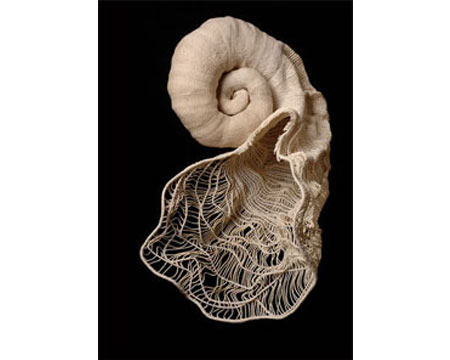
Once again the old proverb holds true: "Good things come in small packages." Acknowledging that "vessels" have been on earth since Homo sapiens became hunter-gathers, it is remarkable, even incredible, what shapes they have taken, what materials they are made of, and what functions they perform in the contemporary world.
This vast diversity is the point of an exquisite exhibit co-curated by Jean Clad (from California) and Wynn Perry (from Ohio), produced in partnership with Owens College in Toledo. On view is the work of thirteen artists who made the vessels from clay, glass, fabric, paper, metal, wood, and twine.
The definition of "vessel" is technically correct for everything on display: Something that holds or contains something else, such as wine, water, food, flowers--even one's soul. Realistically, however, rather than serve any functional purpose, most of the work consists of art objects that are a delight to behold and provocative in concept. Artistic imagination pervades the gallery. "The White Sound" by Carol Shaw-Sutton is a perfect example. Created from the labor-intensive technique of weaving with waxed linen twine, it takes the form of a delicate ancient sea shell reputed to hold the sound of the ocean.
Another eye-catcher is "Flourishment" by Ellen Jantzen. In this case, hand-made paper was molded into a colorful, three-dimensional sculpture that resembles ripened peas in a pod that's bursting open in the sunshine. By contrast, Susanna B. Speirs has crafted a free- standing copper urn that is as timeless as history. Aptly untitled, it could hold wine from ancient Greece, grain from the Middle Ages, water from the Sahara, or ashes from a funeral. Although Rodney Tsukashima began his career making functional ceramic vessels, he now uses this form as a vehicle to express other ideas and concepts. Shown here are two elegant, hand-painted vases with Japanese decoration that illustrates the diversity of "Yin" and "Yang."
By the appearance of Brian Donahue's elegant wooden bowls you'd never guess he was a self-taught artist who harvests his own material, designs his own vessels, embeds his own precious stones and metal, then polishes his projects with skill and aplomb. As for glass, Jeff Mack displays skill at hand-blowing and modeling the hot molten material that is informed by the Venetian tradition. On view is a gorgeous vase with pinched neck: half cloudy white, half citroen yellow, with a delicately etched pattern swirling throughout.
Judy Kahle creates fabric vessels by drawing, painting, dying, and constructing material as a base form onto which she adds layers of colored thread with freehand embroidery. The end results are highly stylized, brightly colored receptacles that are both functional and decorative. Michale F. Rohde's vessels are also fabric, but he achieves his forms by means of intricate knotting techniques with unwaxed linen yarn that is hand-dyed, then built into cones of vibrant multicolored coils.
Danielle Chrissman hammers steel into soft, delicate flower-forms. Karen Roderick-Lingeman’s clay bowls resemble broken artifacts from archeological digs. Thomas S. Madden crafts tall, regal vases out of pewter, copper and silver.
Although his stylized glass works are classified as vessels in the context of this exhibition, Stephen W. Kemmerly insists they were created strictly as art objects, with formal emphasis on texture, form, color and design. By contrast, visitors will be intrigued by Rachelle Woo Chuang's hand-made paper folders, pods and scrolls. The only abstract interpretation among this group, her flat wall-works reduce the concept of vessels to its lowest common denominator.
Published courtesy of ArtScene ©2010
